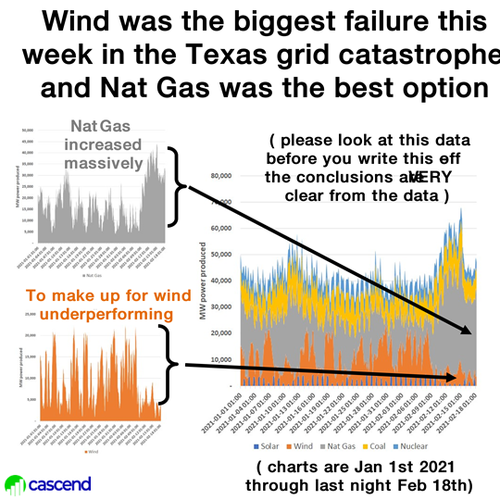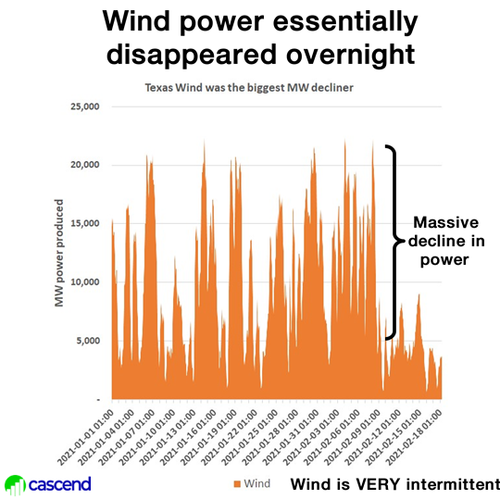Research group blames wind power for Texas grid collapse
02/24/2021 / By Ethan Huff

As things in Texas trickle back towards some semblance of normal post-blackout, the blaming and finger-pointing has begun. Who or what is responsible for the absolute debacle that left millions of Texans without electricity during record-cold temperatures? According to one group, failed wind turbines are to blame.
Cascend Strategy published a report that echoes what some were saying early on about how “green” energy technologies like wind and solar certainly did not help the situation any, especially after it was determined that many wind turbines and solar panels froze over, rendering them useless when they were needed most.
“Ice storms knocked out nearly half the wind power generating capacity of Texas on Sunday as a massive deep freeze across the state locked up wind turbine generators, creating an electricity generation crisis,” the Cascend report explains.
“Natural gas made up the difference for a while … But then everything else followed down.”
 ]
]
Record-cold temperatures caused many Texans to turn up their heaters, which drove demand for electricity “well beyond normal levels,” the report adds. “Wind power failed to deliver its expected power – almost 40% of expected power – in part due to lack of winterized wind turbines.”
 ]
]
Shifting the load to natural gas worked for a while until this, too, failed. Allegations emerged that pipelines had also frozen over, even though they operate just fine in far colder temperatures to the north of Texas.
Apparently, none of the Texas energy grid is properly winterized for extreme weather conditions that, while rare, do occur. All it takes is one dramatic cold spell like the one that swept the state to create a massive disaster, which is exactly what happened.
Texas does not require electric producers to keep power reserves – perhaps that needs to change
Another major problem with the Texas energy grid is the fact that energy suppliers are not required to keep power reserves. Had they been required to, the statewide grid-down event never would have occurred, and lives would have been saved.
“Coal and nuclear both underperformed, but not by much, due to non-winterized equipment,” Cascend explains. “Solar underperformed for a few days but is back, although is far too intermittent to help without storage except during heat waves.”
Cascend’s five-step solution to the problem in Texas includes winterizing all “green” equipment, including windmills; requiring that power companies store reserves; improving Texas’ grid connections; adding solar with storage; and adding more natural gas.
Texas is currently the only state in the union where energy production is separate from the rest of the nation. Everything produced in Texas stays in Texas, and the state is not equipped to buy energy from neighboring states – meaning it is all on its own in the event of a crisis.
One of the biggest morals of this story is that if it ain’t broke, then why try to fix it? Fossil fuels are tried and true, while “green” energy is an experiment much like Wuhan coronavirus (Covid-19) vaccines. Why not just stick with what works rather than try to reinvent the wheel?
“It is sad and ironic that in a state known for its huge petroleum and natural gas resources, the lack of reliability of wind power has brought the state to its knees in a time of crisis, not unlike that which California experienced in 2020 during a record heat where wind and solar power could not keep up with demand and was near collapse,” one report says.
“The folly of chasing renewable energy as a means of mitigating ‘climate change’ is making itself abundantly clear today in Texas. When will politicians wake up and realize that renewable energy almost always equates to unreliable energy?”
More related news about the Texas blackout situation can be found at Collapse.news.
Sources for this article include:
Tagged Under: blackout, Blame Game, Cascend Strategy, deep freeze, electricity, energy, green energy, Green New Deal, green power, grid collapse, grid down, power, power grid, storm, Texas, wind power, Wind Turbines
RECENT NEWS & ARTICLES
PowerGrid.News is a fact-based public education website published by Power Grid News Features, LLC.
All content copyright © 2018 by Power Grid News Features, LLC.
Contact Us with Tips or Corrections
All trademarks, registered trademarks and servicemarks mentioned on this site are the property of their respective owners.



















